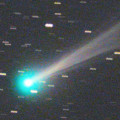
|
Bright new comet. It will approach to Sun down to 0.22 a.u. in mid September, and it is expected to brighten up to 2 mag. Now it is 6.3 mag (Sept. 3, Virgilio Gonano). It will turn to fade out rapidly after brightening. In the Northern Hemisphere, it will be unobservable soon. In the Southern Hemisphere, it is not observable now, but it will appear in October.
Date(TT) R.A. (2000) Decl. Delta r Elong. m1 Best Time(A, h)
Sept. 2 8 50.21 24 1.9 1.038 0.550 31 6.5 4:05 (250, 13)
Sept. 9 10 16.26 22 52.8 0.867 0.372 21 4.4 4:11 (244, 3)
|

|
It is expected to brighten up to 7.5 mag in October. Now it is 11.0 mag (Aug. 27, Juan Jose Gonzalez). Brightening slowly. In the Northern Hemisphere, it stays observable in good condition. In the Southern Hemisphere, it will be getting higher gradually.
Date(TT) R.A. (2000) Decl. Delta r Elong. m1 Best Time(A, h)
Sept. 2 2 50.76 42 41.6 0.448 1.200 104 9.5 4:05 (184, 82)
Sept. 9 3 45.91 42 57.5 0.416 1.160 100 9.0 4:11 (208, 81)
|

|
Now it is 9.6 mag (Aug. 27, Juan Jose Gonzalez). Fading gradually. In the Northern Hemisphere, it will be getting lower gradually. In the Southern Hemisphere, it stays observable in good condition.
Date(TT) R.A. (2000) Decl. Delta r Elong. m1 Best Time(A, h)
Sept. 2 2 42.19 -12 18.4 1.924 2.592 120 9.6 4:00 ( 0, 43)
Sept. 9 2 29.76 -17 8.5 1.876 2.632 129 9.6 3:21 ( 0, 38)
|
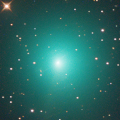
|
It brightened up to 8.4 mag in late July (July 22, Thomas Lehmann). Now it is 9.7 mag (Aug. 25, Chris Wyatt). Fading rapidly. It will be fainter than 18 mag in November. It stays observable in good condition.
Date(TT) R.A. (2000) Decl. Delta r Elong. m1 Best Time(A, h)
Sept. 2 22 1.63 6 43.6 0.441 1.435 161 10.2 23:17 ( 0, 61)
Sept. 9 22 7.45 -3 31.4 0.514 1.509 164 11.0 22:55 ( 0, 51)
|
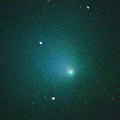
|
It will brighten up to 7.5 mag in October. Now it is 11.1 mag (Aug. 27, Juan Jose Gonzalez). It will turn to fade out rapidly after brightening. It will be unobservable soon in the Southern Hemisphere, or in October in the Northern Hemisphere.
Date(TT) R.A. (2000) Decl. Delta r Elong. m1 Best Time(A, h)
Sept. 2 6 20.10 34 6.5 1.086 1.131 65 11.3 4:05 (255, 47)
Sept. 9 7 11.70 33 26.1 0.995 1.019 61 10.3 4:11 (255, 43)
|

|
It brightened up to 7.8 mag in late July (July 20, Thomas Lehmann). Now it is 11.4 mag (Aug. 24, Ken-ichi Kadota). Fading rapidly. It will be unobservable in October. But it will be observable again in November in the Northern Hemisphere, or in December in the Southern Hemisphere.
Date(TT) R.A. (2000) Decl. Delta r Elong. m1 Best Time(A, h)
Sept. 2 14 53.87 -18 32.4 1.626 1.552 67 10.5 19:53 ( 54, 15)
Sept. 9 14 51.87 -16 46.7 1.830 1.584 59 10.8 19:42 ( 59, 13)
|
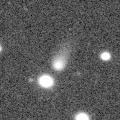
|
It is expected to brighten up to 7 mag in early 2024. Now it is 12.7 mag (Aug. 21, Chris Wyatt). It will brighten rapidly after this. In the Northern Hemisphere, it is not observable now, but it will appear in November. It locates somewhat low in the Southern Hemisphere. But it will become high in winter. The brightness evolution slowed down since May.
Date(TT) R.A. (2000) Decl. Delta r Elong. m1 Best Time(A, h)
Sept. 2 8 56.09 -28 6.7 3.259 2.635 44 11.8 4:05 (293,-17)
Sept. 9 9 11.23 -29 3.8 3.179 2.561 44 11.6 4:11 (296,-14)
|

|
It brightened up to 8 mag from 2022 summer to 2023 spring. Now it is 11.8 mag (Aug. 24, Ken-ichi Kadota). It stays 12 mag for a while. In the Northern Hemisphere, it will be getting higher gradually. In the Southern Hemisphere, it stays observable in good condition.
Date(TT) R.A. (2000) Decl. Delta r Elong. m1 Best Time(A, h)
Sept. 2 6 45.87 -8 14.7 3.899 3.525 61 11.9 4:05 (295, 19)
Sept. 9 6 48.13 -8 12.9 3.875 3.588 66 11.9 4:11 (301, 25)
|
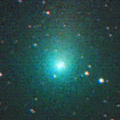
|
It brightened up to 9.5 mag from winter to early spring (Jan. 30, Katsumi Yoshimoto). Now it is 12.2 mag (Aug. 29, Osamu Miyazaki). It will fade out rapidly after this. It stays observable in good condition.
Date(TT) R.A. (2000) Decl. Delta r Elong. m1 Best Time(A, h)
Sept. 2 23 46.66 15 52.7 2.043 2.967 151 12.5 1:06 ( 0, 71)
Sept. 9 23 34.49 12 32.5 2.062 3.031 160 12.7 0:26 ( 0, 68)
|
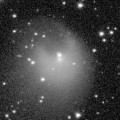
|
It returns for the first time in 70 years. It will brighten up to 4.5 mag in 2024 spring. It suddenly brightened in outburst by 5 mag up to 11.5 mag on July 20 (E. Tamas, Francois Kugel). Now it is 11.7 mag (Aug. 26, Thomas Lehmann). Brightening slowly. In the Northern Hemisphere, it stays observable in good condition. In the Southern Hemisphere, it will be unobservable in October.
Date(TT) R.A. (2000) Decl. Delta r Elong. m1 Best Time(A, h)
Sept. 2 17 24.38 51 59.1 3.276 3.427 89 12.8 19:53 (147, 68)
Sept. 9 17 20.86 50 48.7 3.236 3.351 87 12.9 19:42 (140, 67)
|

|
Now it is 13.7 mag (July 14, Chris Wyatt). It stays 13 mag for a while. In the Northern Hemisphere, it is not observable now, but it will appear in October. In the Southern Hemisphere, it will be unobservable soon. But it will be observable again in September.
Date(TT) R.A. (2000) Decl. Delta r Elong. m1 Best Time(A, h)
Sept. 2 10 34.39 -15 50.6 4.785 3.886 24 13.0 4:05 (268,-31)
Sept. 9 10 36.61 -17 1.4 4.809 3.909 23 13.0 4:11 (274,-25)
|

|
Now it is 13.6 mag (Aug. 25, Chris Wyatt). Fading slowly. In the Northern Hemisphere, it is not observable now. It locates somewhat low in the Southern Hemisphere. But it will become high in autumn. It was expected to brighten up to 10 mag from spring to summer. However, it is fainter than originally expected.
Date(TT) R.A. (2000) Decl. Delta r Elong. m1 Best Time(A, h)
Sept. 2 11 27.03 -75 17.1 3.227 3.275 83 13.4 19:53 ( 18,-38)
Sept. 9 11 32.66 -74 59.3 3.308 3.299 80 13.5 19:42 ( 18,-39)
|

|
It brightened up to 8.3 mag in 2021-2022 winter (Jan. 6, 2022, Toshiyuki Takahashi). Now it is 13.2 mag (July 14, Chris Wyatt). It stays 14 mag for a while. In the Northern Hemisphere, it is not observable now, but it will appear in November. It locates somewhat low in the Southern Hemisphere. But it will become high in autumn.
Date(TT) R.A. (2000) Decl. Delta r Elong. m1 Best Time(A, h)
Sept. 2 10 25.11 -33 50.8 6.960 6.250 42 13.5 4:05 (289,-37)
Sept. 9 10 30.81 -34 32.7 7.019 6.295 41 13.5 4:11 (292,-32)
|
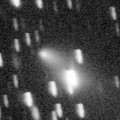
|
Now it is 13.8 mag (Aug. 17, Ken-ichi Kadota). Fading gradually. In the Northern Hemisphere, it stays observable in good condition. In the Southern Hemisphere, it will be unobservable soon.
Date(TT) R.A. (2000) Decl. Delta r Elong. m1 Best Time(A, h)
Sept. 2 2 43.53 46 23.4 1.303 1.826 103 13.7 4:02 (180, 79)
Sept. 9 2 41.63 51 7.3 1.287 1.853 107 13.8 3:33 (180, 74)
|
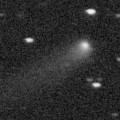
|
Now it is 14.0 mag (Aug. 24, Hiroshi Abe). Fading slowly. It stays observable in good condition.
Date(TT) R.A. (2000) Decl. Delta r Elong. m1 Best Time(A, h)
Sept. 2 1 36.17 7 40.7 2.586 3.365 133 13.8 2:55 ( 0, 63)
Sept. 9 1 20.51 7 29.3 2.514 3.384 144 13.8 2:12 ( 0, 63)
|

|
It will approach to Earth down to 0.2 a.u. in November, and it is expected to brighten up to 7.5 mag. Now it is 14.2 mag (Aug. 23, Thomas Lehmann). Brightening rapidly. It locates somewhat low in the Northern Hemisphere. But it will become high in autumn. In the Southern Hemisphere, it is not observable now, but it will appear in November.
Date(TT) R.A. (2000) Decl. Delta r Elong. m1 Best Time(A, h)
Sept. 2 11 41.61 43 20.6 1.990 1.338 37 14.3 19:53 (133, 14)
Sept. 9 11 44.86 43 29.1 1.871 1.255 38 13.8 19:42 (135, 13)
|

|
Now it is 13.3 mag (Aug. 17, Ken-ichi Kadota). It will fade out rapidly after this. It will be fainter than 18 mag in December. It stays observable in good condition.
Date(TT) R.A. (2000) Decl. Delta r Elong. m1 Best Time(A, h)
Sept. 2 19 29.72 -0 31.3 1.365 2.170 131 14.0 20:45 ( 0, 54)
Sept. 9 19 32.55 -1 1.1 1.440 2.191 126 14.3 20:20 ( 0, 54)
|

|
The ATLAS search program detected its cometary activity in April. It continues to be brightening even after the perihelion passage. Now it is 13.4 mag (Aug. 25, Chris Wyatt). It will fade out rapidly after this. It locates somewhat low in the Northern Hemisphere. But it will become high in autumn. In the Southern Hemisphere, it stays observable in good condition.
Date(TT) R.A. (2000) Decl. Delta r Elong. m1 Best Time(A, h)
Sept. 2 23 53.38 -27 22.8 2.029 2.972 154 14.0 1:12 ( 0, 28)
Sept. 9 23 49.65 -27 29.4 2.054 3.002 155 14.1 0:41 ( 0, 28)
|

|
Now it is 13.3 mag (Aug. 22, Jean-Francois Soulier). In the Northern Hemisphere, it will be getting higher gradually. It locates somewhat low in the Southern Hemisphere.
Date(TT) R.A. (2000) Decl. Delta r Elong. m1 Best Time(A, h)
Sept. 2 8 11.64 22 41.5 6.884 6.132 38 14.1 4:05 (256, 20)
Sept. 9 8 16.39 22 24.6 6.811 6.134 44 14.1 4:11 (260, 25)
|
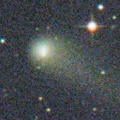
|
It brightened up to 11.1 mag in early 2022 (Mar. 31, 2022, F. Kugel, J.-G. Bosch, J. Nicolas). Now it is 14.2 mag (Aug. 17, Thomas Lehmann). It stays 15 mag for a while. In the Northern Hemisphere, it will be getting lower gradually. But it will be getting higher again after December. In the Southern Hemisphere, it will be unobservable in October.
Date(TT) R.A. (2000) Decl. Delta r Elong. m1 Best Time(A, h)
Sept. 2 15 26.95 18 41.4 5.866 5.595 69 14.2 19:53 ( 82, 45)
Sept. 9 15 30.87 18 15.6 5.977 5.631 65 14.3 19:42 ( 83, 42)
|
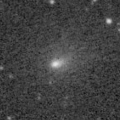
|
Now it is 14.3 mag (Aug. 22, Thomas Lehmann). It will fade out rapidly after this. It will be fainter than 18 mag in November. In the Northern Hemisphere, it will be getting lower gradually. In the Southern Hemisphere, it stays observable in good condition.
Date(TT) R.A. (2000) Decl. Delta r Elong. m1 Best Time(A, h)
Sept. 2 19 3.48 -1 13.9 0.936 1.726 125 14.2 20:18 ( 0, 53)
Sept. 9 18 55.50 -9 57.1 1.079 1.784 117 14.7 19:43 ( 0, 45)
|
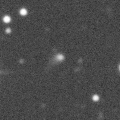
|
Now it is 15.6 mag (July 8, Thomas Lehmann). Brightening slowly. In the Northern Hemisphere, it is not observable now, but it will be observable soon. It locates somewhat low in the Southern Hemisphere. But it will become high in autumn. It is expected to brighten up to 12 mag from 2024 to 2025.
Date(TT) R.A. (2000) Decl. Delta r Elong. m1 Best Time(A, h)
Sept. 2 9 27.16 3 37.4 5.874 4.933 19 14.7 4:05 (261, -6)
Sept. 9 9 30.03 3 46.0 5.794 4.894 24 14.6 4:11 (266, 0)
|
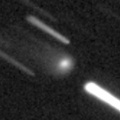
|
Now it is 14.8 mag (Aug. 18, Ken-ichi Kadota). It stays 14 mag for a while. It will be getting lower gradually after this, and it will be unobservable in October in the Southern Hemisphere, or in November in the Northern Hemisphere. But it will be observable again in December. It is expected to brighten up to 12.5 mag in 2024 spring. At the high light, it will be observable in excellent condition in the Southern Hemisphere, but it will be low in the Northern Hemisphere.
Date(TT) R.A. (2000) Decl. Delta r Elong. m1 Best Time(A, h)
Sept. 2 15 11.13 5 36.4 3.608 3.340 66 14.7 19:53 ( 71, 34)
Sept. 9 15 9.14 3 59.9 3.683 3.300 60 14.7 19:42 ( 72, 29)
|

|
Now it is 14.3 mag (July 7, Thomas Lehmann). Fading slowly. In the Northern Hemisphere, it is not observable now. It stays extremely low in the Southern Hemisphere. But it will become high in winter.
Date(TT) R.A. (2000) Decl. Delta r Elong. m1 Best Time(A, h)
Sept. 2 11 8.71 -48 29.2 2.911 2.509 56 14.8 19:53 ( 52,-39)
Sept. 9 11 32.93 -48 51.6 3.002 2.556 54 14.9 19:42 ( 52,-38)
|
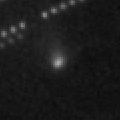
|
It brightened very rapidly. Now it is 15.2 mag (Aug. 23, ATLAS South Africa). It will fade out rapidly after this. It will be fainter than 18 mag in December. In the Northern Hemisphere, it is not observable now, but it will appear in November. In the Southern Hemisphere, it will be getting lower gradually after this, and it will be unobservable in October.
Date(TT) R.A. (2000) Decl. Delta r Elong. m1 Best Time(A, h)
Sept. 2 13 58.06 -27 18.0 2.364 2.041 59 14.9 19:53 ( 57, -1)
Sept. 9 14 1.50 -24 55.5 2.496 2.040 52 15.0 19:42 ( 60, -1)
|
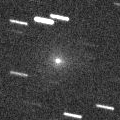
|
It was expected to brighten up to 11 mag in July. But actually, it is fainter than originally expected. Now it is 13.0 mag (Aug. 19, Thomas Lehmann). Fading rapidly. It will be fainter than 18 mag in October. It locates somewhat low.
Date(TT) R.A. (2000) Decl. Delta r Elong. m1 Best Time(A, h)
Sept. 2 8 23.93 11 13.8 1.877 1.187 34 14.9 4:05 (264, 11)
Sept. 9 8 44.74 9 17.9 1.920 1.247 35 15.4 4:11 (268, 13)
|
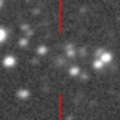
|
Now it is 14.6 mag (Aug. 5, J. L. Virlichie, P. Traverse, H. Roy, G. Houdin). Fading slowly. It locates somewhat low in the Northern Hemisphere. In the Southern Hemisphere, it stays observable in good condition.
Date(TT) R.A. (2000) Decl. Delta r Elong. m1 Best Time(A, h)
Sept. 2 17 58.44 -32 30.1 2.406 2.916 110 15.0 19:53 ( 9, 22)
Sept. 9 18 2.82 -32 58.7 2.497 2.920 104 15.1 19:42 ( 11, 21)
|

|
It approached to Earth down to 0.29 a.u. in early February, and it brightened up to 4.5 mag (Feb. 1, Juan Jose Gonzalez). Now it is 14.1 mag (Aug. 19, Thomas Lehmann). Fading slowly. In the Northern Hemisphere, it will be unobservable in October. In the Southern Hemisphere, it stays observable in good condition.
Date(TT) R.A. (2000) Decl. Delta r Elong. m1 Best Time(A, h)
Sept. 2 6 39.41 -38 19.9 3.544 3.390 73 15.1 4:05 (318, -1)
Sept. 9 6 40.05 -40 45.0 3.559 3.466 76 15.2 4:11 (325, 2)
|

|
It will brighten up to 14 mag from 2024 to 2025. Now it is 15.2 mag (July 22, ATLAS Chile). It stays 15 mag for a while. In the Northern Hemisphere, it is not observable now, but it will appear in November. It locates somewhat low in the Southern Hemisphere. But it will become high in autumn.
Date(TT) R.A. (2000) Decl. Delta r Elong. m1 Best Time(A, h)
Sept. 2 10 26.69 -27 40.7 6.520 5.735 36 15.2 4:05 (282,-35)
Sept. 9 10 33.73 -28 1.0 6.510 5.710 34 15.1 4:11 (285,-30)
|

|
It has not been observed yet in this apparition. It was expected to brighten rapidly up to 15 mag in summer. But actually, it is not detected, fainter than 19 mag (Aug. 12, Martin Masek). It stays 16 mag for a while. It locates somewhat low in the Northern Hemisphere. In the Southern Hemisphere, it stays observable in good condition.
Date(TT) R.A. (2000) Decl. Delta r Elong. m1 Best Time(A, h)
Sept. 2 17 12.75 -28 10.5 1.614 2.054 100 15.3 19:53 ( 20, 24)
Sept. 9 17 22.90 -27 33.5 1.672 2.041 95 15.3 19:42 ( 22, 24)
|
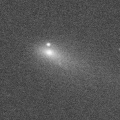
|
It brightened up to 12.8 mag in spring (Mar. 8, Taras Prystavski). Now it is 15.9 mag (Aug. 18, Ken-ichi Kadota). It will fade out rapidly after this. It will be fainter than 18 mag in November. It stays observable in good condition.
Date(TT) R.A. (2000) Decl. Delta r Elong. m1 Best Time(A, h)
Sept. 2 1 29.69 -3 21.8 1.640 2.484 138 15.6 2:48 ( 0, 52)
Sept. 9 1 25.22 -3 51.5 1.626 2.523 145 15.7 2:16 ( 0, 51)
|

|
Now it is 14.6 mag (Aug. 17, Thomas Lehmann). Fading gradually. It will be fainter than 18 mag in December. It locates somewhat low in the Northern Hemisphere. In the Southern Hemisphere, it will be getting lower gradually after this, and it will be unobservable in December.
Date(TT) R.A. (2000) Decl. Delta r Elong. m1 Best Time(A, h)
Sept. 2 17 13.94 -20 49.5 2.415 2.778 100 15.7 19:53 ( 23, 31)
Sept. 9 17 20.13 -21 5.2 2.547 2.819 94 15.9 19:42 ( 25, 30)
|

|
Now it is 15.7 mag (Aug. 24, Thomas Lehmann). Fading slowly. It stays observable in good condition.
Date(TT) R.A. (2000) Decl. Delta r Elong. m1 Best Time(A, h)
Sept. 2 0 42.39 -6 21.9 2.705 3.616 150 15.8 2:01 ( 0, 49)
Sept. 9 0 38.74 -6 47.2 2.681 3.631 157 15.8 1:30 ( 0, 48)
|

|
It will approach to Sun down to 0.4 a.u. in late September in 2024, and it is expected to brighten up to 0 mag. Now it is 15.9 mag (Aug. 13, ATLAS South Africa). Brightening slowly. It will be unobservable in October. But it will be observable again in November in the Northern Hemisphere, or in December in the Southern Hemisphere. At the high light, in the Northern Hemisphere, it will be observable in good condition after the perihelion passage. In the Southern Hemisphere, it will be observable in the low sky before and after the perihelion passage.
Date(TT) R.A. (2000) Decl. Delta r Elong. m1 Best Time(A, h)
Sept. 2 14 5.40 0 7.3 6.103 5.527 51 15.9 19:53 ( 77, 18)
Sept. 9 14 7.04 -0 21.2 6.120 5.457 45 15.8 19:42 ( 79, 15)
|
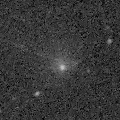
|
Very large comet. It is expected to brighten up to 13 mag in 2031. Now it is 15.7 mag (Aug. 19, Thomas Lehmann). It stays 16 mag for a while. In the Northern Hemisphere, it is not observable now. In the Southern Hemisphere, it stays observable in good condition. In the Northern Hemisphere, it is not observable until 2030.
Date(TT) R.A. (2000) Decl. Delta r Elong. m1 Best Time(A, h)
Sept. 2 3 33.85 -62 36.4 16.986 17.277 105 16.3 4:05 (355, -8)
Sept. 9 3 33.56 -63 4.1 16.956 17.252 105 16.3 4:11 (359, -8)
|
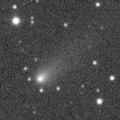
|
Now it is 16.1 mag (Aug. 26, ATLAS South Africa). Fading slowly. It will be fainter than 18 mag in November. In the Northern Hemisphere, it will never be observable after this. In the Southern Hemisphere, it will be getting lower gradually.
Date(TT) R.A. (2000) Decl. Delta r Elong. m1 Best Time(A, h)
Sept. 2 14 47.84 -37 45.0 2.648 2.549 73 16.3 19:53 ( 42, 0)
Sept. 9 15 0.68 -38 20.2 2.738 2.566 69 16.4 19:42 ( 42, -1)
|
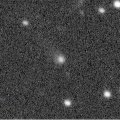
|
Now it is 16.5 mag (Apr. 10, Michael Jager). It stays 16 mag for a while. In the Northern Hemisphere, it is not observable now, but it will appear in October. In the Southern Hemisphere, it will be getting higher gradually.
Date(TT) R.A. (2000) Decl. Delta r Elong. m1 Best Time(A, h)
Sept. 2 9 13.24 -25 55.1 4.422 3.711 40 16.4 4:05 (289,-20)
Sept. 9 9 17.70 -27 46.4 4.386 3.708 42 16.4 4:11 (294,-15)
|
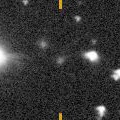
|
It is expected to brighten up to 14 mag in 2024 summer. At the high light, it is not observable in the Northern Hemisphere. Now it is 17.1 mag (Aug. 27, ATLAS Chile). Brightening slowly. It stays observable in good condition.
Date(TT) R.A. (2000) Decl. Delta r Elong. m1 Best Time(A, h)
Sept. 2 3 31.58 0 12.8 3.791 4.206 107 16.6 4:05 (341, 54)
Sept. 9 3 30.55 -1 31.2 3.640 4.157 114 16.5 4:11 (356, 54)
|

|
It is expected to brighten up to 14.5 mag in winter. Now it is 17.8 mag (Aug. 3, Ken-ichi Kadota). Brightening slowly. It stays observable in good condition.
Date(TT) R.A. (2000) Decl. Delta r Elong. m1 Best Time(A, h)
Sept. 2 3 22.64 13 43.9 2.349 2.816 107 16.8 4:05 (337, 67)
Sept. 9 3 26.58 14 6.4 2.229 2.779 112 16.6 4:11 (356, 69)
|
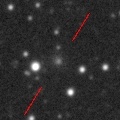
|
Now it is 16.9 mag (Aug. 24, ATLAS Chile). It stays 17 mag for a while. In the Northern Hemisphere, it stays observable in good condition. In the Southern Hemisphere, it will be getting lower gradually after this, and it will be unobservable in December.
Date(TT) R.A. (2000) Decl. Delta r Elong. m1 Best Time(A, h)
Sept. 2 17 47.68 -11 15.0 2.098 2.588 107 16.6 19:53 ( 17, 42)
Sept. 9 17 52.04 -11 30.0 2.164 2.570 101 16.7 19:42 ( 20, 41)
|

|
It approached to Sun down to 0.05 a.u. on Aug. 21, and it must have brightened up to 5.5 mag. Fading rapidly. It will be fainter than 18 mag soon. It will never be observable after this.
Date(TT) R.A. (2000) Decl. Delta r Elong. m1 Best Time(A, h)
Sept. 2 11 22.36 2 23.8 1.461 0.514 11 16.7 19:53 (102,-14)
Sept. 9 11 54.33 -1 55.2 1.644 0.709 13 18.5 19:42 ( 97,-13)
|

|
Very far object. Now it is 17.0 mag (Aug. 26, Jean-Claude Merlin). It stays 17 mag for a while. In the Northern Hemisphere, it is not observable now. In the Southern Hemisphere, it stays observable in good condition.
Date(TT) R.A. (2000) Decl. Delta r Elong. m1 Best Time(A, h)
Sept. 2 5 48.53 -71 45.4 10.224 10.321 92 16.8 4:05 (346,-21)
Sept. 9 5 46.86 -72 27.1 10.228 10.319 92 16.8 4:11 (349,-20)
|

|
It brightened up to 14.1 mag in 2022 spring (Mar. 22, 2022, Chris Wyatt). It was expected to brighten up to 13 mag. But actually, it was fainter than originally expected. Now it is 16.5 mag (Aug. 17, Thomas Lehmann). It stays 17 mag for a while. It stays observable in good condition.
Date(TT) R.A. (2000) Decl. Delta r Elong. m1 Best Time(A, h)
Sept. 2 2 54.02 -2 33.6 4.585 5.124 117 16.9 4:05 (357, 52)
Sept. 9 2 49.39 -2 34.6 4.532 5.171 124 16.9 3:40 ( 0, 53)
|

|
It will brighten rapidly after this. It will be unobservable in October. But it will be observable again in November.
Date(TT) R.A. (2000) Decl. Delta r Elong. m1 Best Time(A, h)
Sept. 2 7 49.63 23 11.1 1.650 1.159 43 17.2 4:05 (258, 24)
Sept. 9 8 18.50 20 58.8 1.515 1.050 43 16.9 4:11 (261, 24)
|

|
It brightened up to 13.4 mag in last summer (July 7, 2022, Giuseppe Pappa). Now it is 17.2 mag (Aug. 25, ATLAS-HKO, Haleakala). It stays 17 mag for a while. In the Northern Hemisphere, it will be getting lower gradually. But it will be getting higher again after November. In the Southern Hemisphere, it will be unobservable in October.
Date(TT) R.A. (2000) Decl. Delta r Elong. m1 Best Time(A, h)
Sept. 2 15 19.50 30 57.8 4.752 4.475 68 17.0 19:53 ( 99, 49)
Sept. 9 15 20.35 30 32.2 4.869 4.522 64 17.1 19:42 (100, 45)
|

|
It has not been observed yet in this apparition. It tends to brighten after the perihelion passage. It will fade out rapidly after this. It will be fainter than 18 mag in November. In the Northern Hemisphere, it will never be observable after this. In the Southern Hemisphere, it will be unobservable in October.
Date(TT) R.A. (2000) Decl. Delta r Elong. m1 Best Time(A, h)
Sept. 2 12 15.72 0 9.5 2.198 1.348 24 17.3 19:53 ( 93, -4)
Sept. 9 12 38.75 -2 0.2 2.209 1.352 24 17.0 19:42 ( 90, -4)
|
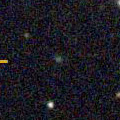
|
Now it is 17.5 mag (Aug. 26, ATLAS-HKO, Haleakala). It stays 17 mag for a while. In the Northern Hemisphere, it stays observable in good condition. It stays extremely low in the Southern Hemisphere.
Date(TT) R.A. (2000) Decl. Delta r Elong. m1 Best Time(A, h)
Sept. 2 4 53.11 38 4.7 6.788 6.737 82 17.1 4:05 (254, 64)
Sept. 9 4 56.01 38 28.4 6.678 6.731 88 17.0 4:11 (253, 71)
|
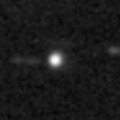
|
Now it is 16.4 mag (Aug. 10, Ken-ichi Kadota). Fading gradually. It will be fainter than 18 mag in October. It stays observable in good condition. It was very faint as 21.5 mag in 2021. It seems to be bright temporarily in outburst.
Date(TT) R.A. (2000) Decl. Delta r Elong. m1 Best Time(A, h)
Sept. 2 21 15.41 -11 27.6 3.554 4.507 158 17.1 22:30 ( 0, 44)
Sept. 9 21 12.41 -11 38.0 3.614 4.521 150 17.2 22:00 ( 0, 43)
|
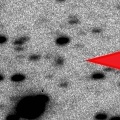
|
Now it is 16.9 mag (Aug. 6, Jean-Claude Merlin). It stays 17 mag for a while. It will be unobservable in October in the Northern Hemisphere, or in November in the Southern Hemisphere. But it will be observable again in December in the Southern Hemisphere. It stays 16 mag in the Southern sky for a long time from 2024 to 2025.
Date(TT) R.A. (2000) Decl. Delta r Elong. m1 Best Time(A, h)
Sept. 2 16 28.87 -40 4.8 6.337 6.464 92 17.1 19:53 ( 24, 9)
Sept. 9 16 26.42 -39 54.7 6.429 6.434 85 17.1 19:42 ( 28, 8)
|

|
Now it is 16.7 mag (Aug. 28, Ken-ichi Kadota). It stays 17 mag for a while. It stays observable in good condition.
Date(TT) R.A. (2000) Decl. Delta r Elong. m1 Best Time(A, h)
Sept. 2 4 55.03 -9 57.4 7.563 7.601 88 17.2 4:05 (320, 36)
Sept. 9 4 56.69 -10 14.2 7.437 7.568 93 17.1 4:11 (329, 39)
|
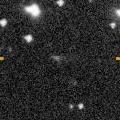
|
First return of a new periodic comet which brightened up to 15 mag in 2008. Now it is 17.4 mag (Aug. 3, Ken-ichi Kadota). Fading gradually. It will be fainter than 18 mag in November. It stays observable in good condition.
Date(TT) R.A. (2000) Decl. Delta r Elong. m1 Best Time(A, h)
Sept. 2 3 54.10 20 33.7 2.187 2.537 98 17.4 4:05 (310, 69)
Sept. 9 3 59.70 19 44.4 2.125 2.561 103 17.4 4:11 (328, 73)
|

|
It is expected to brighten up to 15 mag from autumn to winter. Now it is 18.7 mag (Aug. 11, Giuseppe Pappa). Brightening gradually. In the Northern Hemisphere, it is not observable now, but it will appear in October. In the Southern Hemisphere, it stays observable in good condition.
Date(TT) R.A. (2000) Decl. Delta r Elong. m1 Best Time(A, h)
Sept. 2 3 0.06 -57 24.4 1.486 2.068 110 17.8 4:05 (358, -2)
Sept. 9 2 56.62 -58 10.2 1.439 2.037 111 17.5 3:47 ( 0, -3)
|

|
Now it is 17.3 mag (Aug. 27, ATLAS Chile). It stays 18 mag for a while. It stays observable in good condition.
Date(TT) R.A. (2000) Decl. Delta r Elong. m1 Best Time(A, h)
Sept. 2 3 50.23 8 40.9 2.650 3.017 101 17.6 4:05 (327, 60)
Sept. 9 3 54.00 8 25.0 2.571 3.027 107 17.6 4:11 (342, 62)
|
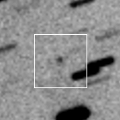
|
Now it is 17.9 mag (Aug. 28, Ken-ichi Kadota). It stays 17 mag for a while. In the Northern Hemisphere, it stays observable in good condition. In the Southern Hemisphere, it is not observable now, but it will appear in November.
Date(TT) R.A. (2000) Decl. Delta r Elong. m1 Best Time(A, h)
Sept. 2 2 26.24 55 6.3 4.228 4.539 101 17.7 3:45 (180, 70)
Sept. 9 2 13.41 56 15.0 4.112 4.517 107 17.6 3:05 (180, 69)
|

|
Now it is 17.6 mag (Aug. 7, Hirohisa Sato). It stays 18 mag for a while. In the Northern Hemisphere, it will be getting lower gradually. It stays extremely low in the Southern Hemisphere.
Date(TT) R.A. (2000) Decl. Delta r Elong. m1 Best Time(A, h)
Sept. 2 14 56.44 30 39.8 3.227 2.913 63 17.7 19:53 (101, 44)
Sept. 9 15 8.04 28 38.9 3.270 2.921 61 17.7 19:42 ( 99, 42)
|

|
It has not been observed yet in this apparition. It is expected to brighten up to 7 mag, and it will be observable in good condition in winter. Brightening rapidly. In the Northern Hemisphere, it stays observable in good condition. It locates somewhat low in the Southern Hemisphere. But it will become high in winter.
Date(TT) R.A. (2000) Decl. Delta r Elong. m1 Best Time(A, h)
Sept. 2 4 44.93 19 32.0 1.564 1.811 86 18.2 4:05 (293, 60)
Sept. 9 5 2.61 20 9.7 1.457 1.760 89 17.7 4:11 (297, 63)
|

|
Now it is 18.8 mag (Feb. 17, Toshihiko Ikemura, Hirohisa Sato). It stays 17 mag for a while. In the Northern Hemisphere, it stays observable in good condition. It stays extremely low in the Southern Hemisphere.
Date(TT) R.A. (2000) Decl. Delta r Elong. m1 Best Time(A, h)
Sept. 2 4 57.08 39 6.1 5.513 5.464 81 17.8 4:05 (251, 64)
Sept. 9 5 0.91 39 8.5 5.386 5.440 87 17.7 4:11 (251, 70)
|

|
Now it is 18.0 mag (July 28, Ken-ichi Kadota). Fading slowly. It will be fainter than 18 mag in October. It stays observable in good condition.
Date(TT) R.A. (2000) Decl. Delta r Elong. m1 Best Time(A, h)
Sept. 2 22 59.02 -15 57.7 2.048 3.049 171 17.8 0:18 ( 0, 39)
Sept. 9 22 55.14 -16 55.7 2.059 3.052 168 17.8 23:42 ( 0, 38)
|

|
It brightened up to 14 mag from 2020 to 2021. Now it is 17.9 mag (Aug. 24, W. Hasubick). It stays 18 mag for a while. It stays observable in good condition.
Date(TT) R.A. (2000) Decl. Delta r Elong. m1 Best Time(A, h)
Sept. 2 3 9.97 4 41.6 4.223 4.695 112 18.0 4:05 (349, 59)
Sept. 9 3 9.65 4 30.6 4.139 4.707 118 17.9 4:00 ( 0, 60)
|
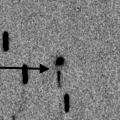
|
David Rankin detected its cometary activity in June. Now it is 16.4 mag (Aug. 17, Martin Masek). Fading slowly. It stays observable in good condition. It is brighter than this ephemeris recently.
Date(TT) R.A. (2000) Decl. Delta r Elong. m1 Best Time(A, h)
Sept. 2 22 17.87 -3 22.3 1.347 2.350 172 18.0 23:32 ( 0, 52)
Sept. 9 22 13.75 -3 33.7 1.333 2.324 166 18.1 23:01 ( 0, 52)
|

|
It returned for the first time in 68 years. It will brighten up to 7.5 mag in 2024 summer. Now it is 21.0 mag (Aug. 26, Alan Hale). It will brighten rapidly after this. It stays observable in good condition. At the high light, it locates low in the Northern Hemisphere, or it is not observable in the Southern Hemisphere.
Date(TT) R.A. (2000) Decl. Delta r Elong. m1 Best Time(A, h)
Sept. 2 4 23.94 -15 30.4 3.682 3.927 96 20.4 4:05 (331, 35)
Sept. 9 4 26.14 -16 3.9 3.532 3.861 101 20.1 4:11 (340, 37)
|
|
![]()
 71P/Clark
71P/Clark 81P/Wild 2
81P/Wild 2 117P/Helin-Roman-Alu 1
117P/Helin-Roman-Alu 1 C/2023 A3 ( Tsuchinshan-ATLAS )
C/2023 A3 ( Tsuchinshan-ATLAS ) C/2014 UN271 ( Bernardinelli-Bernstein )
C/2014 UN271 ( Bernardinelli-Bernstein ) 77P/Longmore
77P/Longmore C/2022 A3 ( Lemmon-ATLAS )
C/2022 A3 ( Lemmon-ATLAS ) C/2022 S4 ( Lemmon )
C/2022 S4 ( Lemmon ) 32P/Comas Sola
32P/Comas Sola 219P/LINEAR
219P/LINEAR 322P/SOHO
322P/SOHO C/2019 E3 ( ATLAS )
C/2019 E3 ( ATLAS ) C/2020 Y2 ( ATLAS )
C/2020 Y2 ( ATLAS ) (3200) Phaethon
(3200) Phaethon C/2020 R7 ( ATLAS )
C/2020 R7 ( ATLAS ) 339P/Gibbs
339P/Gibbs C/2021 S4 ( Tsuchinshan )
C/2021 S4 ( Tsuchinshan ) P/2023 M4 ( ATLAS )
P/2023 M4 ( ATLAS ) C/2023 F3 ( ATLAS )
C/2023 F3 ( ATLAS ) C/2022 QE78 ( ATLAS )
C/2022 QE78 ( ATLAS ) 465P/2023 L1 ( Hill )
465P/2023 L1 ( Hill ) 226P/Pigott-LINEAR-Kowalski
226P/Pigott-LINEAR-Kowalski 170P/Christensen
170P/Christensen C/2022 U1 ( Leonard )
C/2022 U1 ( Leonard ) C/2022 U4 ( Bok )
C/2022 U4 ( Bok ) 62P/Tsuchinshan 1
62P/Tsuchinshan 1 C/2022 U3 ( Bok )
C/2022 U3 ( Bok ) 287P/Christensen
287P/Christensen 246P/NEAT
246P/NEAT 2023 KF3
2023 KF3 13P/Olbers
13P/Olbers![]()






















































